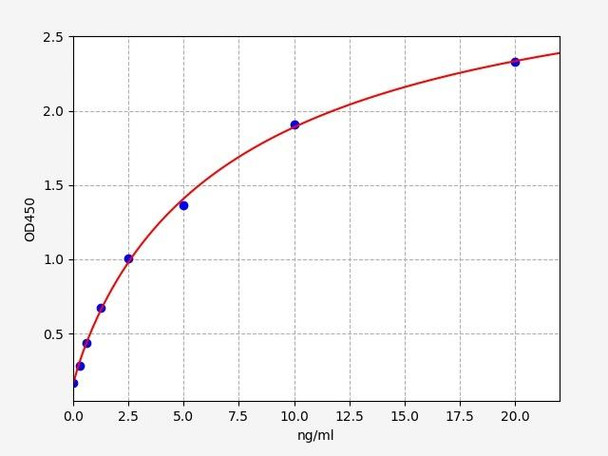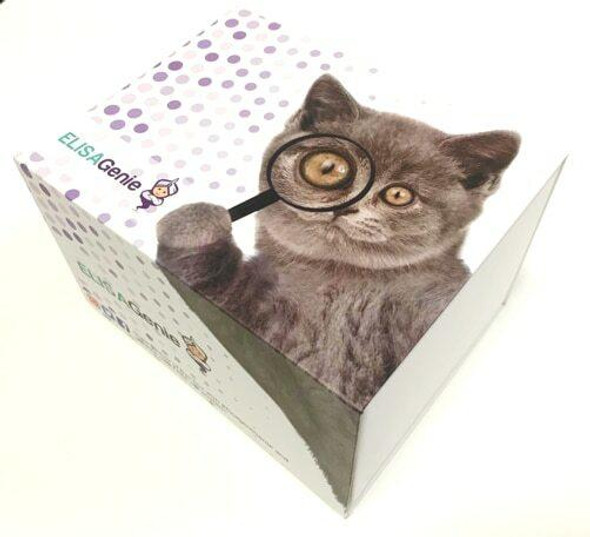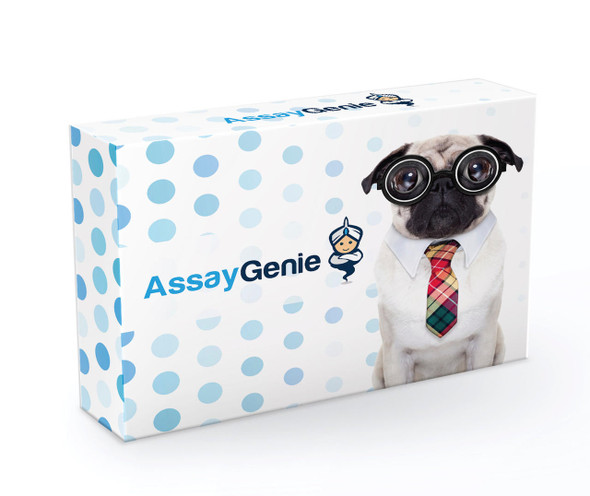Human Carcinoembryonic antigen / CEA ELISA Kit (HUFI00080)
- SKU:
- HUFI00080
- Product Type:
- ELISA Kit
- Size:
- 96 Assays
- Uniprot:
- P06731
- Sensitivity:
- 0.188ng/ml
- Range:
- 0.313-20ng/ml
- ELISA Type:
- Sandwich
- Synonyms:
- CEA, Carcinoembryonic antigen, CD66E, CD66, CEACAM5, Carcinoembryonic Antigen-related Cell Adhesion Molecule 5, Meconium antigen 100
- Reactivity:
- Human
- Research Area:
- Cell Death
Description
Human Carcinoembryonic antigen / CEA ELISA Kit
Carcinoembryonic antigen (CEA) is a glycoprotein that is produced by cells that are cancerous. As such, the presence of CEA can be used to detect cancer cells in the body. Carcinoembryonic antigen/CEA has been found to be elevated in people with certain cancers, such as colon, stomach, breast, pancreatic, and lung cancers. Carcinoembryonic antigen is a protein that plays a key role in the function of the immune system. The Assay Genie Human Carcinoembryonic antigen/CEA ELISA kit is a highly sensitive assay for the quantitative measurement of CEA in serum, blood, plasma, cell culture supernatant, and tissue samples.
Key Features
| Save Time | Pre-coated 96 well plate | |
| Quick Start | Kit includes all necessary reagents | |
| Publication Ready | Reproducible and reliable results |
Overview
| Product Name: | Human Carcinoembryonic antigen / CEA ELISA Kit |
| Product Code: | HUFI00080 |
| Size: | 96 Assays |
| Alias: | CEA, Carcinoembryonic antigen, CD66E, CD66, CEACAM5, Carcinoembryonic Antigen-related Cell Adhesion Molecule 5, Meconium antigen 100 |
| Detection Method: | Sandwich ELISA, Double Antibody |
| Application: | This immunoassay kit allows for the in vitro quantitative determination of Human CEA concentrations in serum plasma and other biological fluids. |
| Sensitivity: | 0.188ng/ml |
| Range: | 0.313-20ng/ml |
| Storage: | 4°C for 6 months |
| Note: | For Research Use Only |
Additional Information
| Intra-Assay: CV<8% Inter-Assay: CV<10% | |||||||||||||||||||||
| Recovery: | Matrices listed below were spiked with certain level of Human CEA and the recovery rates were calculated by comparing the measured value to the expected amount of Human CEA in samples.
| ||||||||||||||||||||
| Linearity: | The linearity of the kit was assayed by testing samples spiked with appropriate concentration of Human CEA and their serial dilutions. The results were demonstrated by the percentage of calculated concentration to the expected.
| ||||||||||||||||||||
| CV(%): | Intra-Assay: CV<8% |
Kit Components
| Component | Quantity | Storage |
| ELISA Microplate (Dismountable) | 8x12 strips | 4°C for 6 months |
| Lyophilized Standard | 2 | 4°C/ -20°C |
| Sample/Standard Dlution Buffer | 20ml | 4°C |
| Biotin-labeled Antibody (Concentrated) | 120ul | 4°C (Protection from light) |
| Antibody Dilution Buffer | 10ml | 4°C |
| HRP-Streptavidin Conjugate (SABC) | 120ul | 4°C (Protect from light) |
| SABC Dilution Buffer | 10ml | 4°C |
| TMB Substrate | 10ml | 4°C (Protection from light) |
| Stop Solution | 10ml | 4°C |
| Wash Buffer (25X) | 30ml | 4°C |
| Plate Sealer | 5 | - |
Other materials required:
- Microplate reader with 450 nm wavelength filter
- Multichannel Pipette, Pipette, microcentrifuge tubes and disposable pipette tips
- Incubator
- Deionized or distilled water
- Absorbent paper
- Buffer resevoir
Protein Information
| Uniprot: | |
| UniProt Protein Function: | CEACAM5: Cell surface glycoprotein that plays a role in cell adhesion and in intracellular signaling. Receptor for E.coli Dr adhesins. Homodimer. Binding of E.coli Dr adhesins leads to dissociation of the homodimer. Found in adenocarcinomas of endodermally derived digestive system epithelium and fetal colon. Belongs to the immunoglobulin superfamily. CEA family. |
| UniProt Code: | |
| NCBI GenInfo Identifier: | |
| NCBI Gene ID: | |
| NCBI Accession: | |
| UniProt Related Accession: | |
| Molecular Weight: | 76,795 Da |
| NCBI Full Name: | Carcinoembryonic antigen-related cell adhesion molecule 5 |
| NCBI Official Symbol: | CEACAM5 |
| NCBI Official Synonym Symbols: | CEA; CD66e |
| NCBI Protein Information: | carcinoembryonic antigen-related cell adhesion molecule 5; meconium antigen 100 |
| UniProt Protein Name: | Carcinoembryonic antigen-related cell adhesion molecule 5 |
| UniProt Synonym Protein Names: | Carcinoembryonic antigen; CEA; Meconium antigen 100 |
Protocol
*Note: Protocols are specific to each batch/lot. For the exact instructions please follow the protocol included in your kit.
Before adding to wells, equilibrate the SABC working solution and TMB substrate for at least 30 min at 37°C. When diluting samples and reagents, they must be mixed completely and evenly. It is recommended to plot a standard curve for each test.
| Step | Procedure |
| 1. | Set standard, test sample and control (zero) wells on the pre-coated plate respectively, and then, record their positions. It is recommended to measure each standard and sample in duplicate. Wash plate 2 times before adding standard, sample and control (zero) wells! |
| 2. | Aliquot 0.1ml standard solutions into the standard wells. |
| 3. | Add 0.1 ml of Sample / Standard dilution buffer into the control (zero) well. |
| 4. | Add 0.1 ml of properly diluted sample ( Human serum, plasma, tissue homogenates and other biological fluids.) into test sample wells. |
| 5. | Seal the plate with a cover and incubate at 37 °C for 90 min. |
| 6. | Remove the cover and discard the plate content, clap the plate on the absorbent filter papers or other absorbent material. Do NOT let the wells completely dry at any time. Wash plate X2. |
| 7. | Add 0.1 ml of Biotin- detection antibody working solution into the above wells (standard, test sample & zero wells). Add the solution at the bottom of each well without touching the side wall. |
| 8. | Seal the plate with a cover and incubate at 37°C for 60 min. |
| 9. | Remove the cover, and wash plate 3 times with Wash buffer. Let wash buffer rest in wells for 1 min between each wash. |
| 10. | Add 0.1 ml of SABC working solution into each well, cover the plate and incubate at 37°C for 30 min. |
| 11. | Remove the cover and wash plate 5 times with Wash buffer, and each time let the wash buffer stay in the wells for 1-2 min. |
| 12. | Add 90 µl of TMB substrate into each well, cover the plate and incubate at 37°C in dark within 10-20 min. (Note: This incubation time is for reference use only, the optimal time should be determined by end user.) And the shades of blue can be seen in the first 3-4 wells (with most concentrated standard solutions), the other wells show no obvious color. |
| 13. | Add 50 µl of Stop solution into each well and mix thoroughly. The color changes into yellow immediately. |
| 14. | Read the O.D. absorbance at 450 nm in a microplate reader immediately after adding the stop solution. |
Sample Type
When carrying out an ELISA assay it is important to prepare your samples in order to achieve the best possible results. Below we have a list of procedures for the preparation of samples for different sample types.
| Sample Type | Protocol |
| Serum | If using serum separator tubes, allow samples to clot for 30 minutes at room temperature. Centrifuge for 10 minutes at 1,000x g. Collect the serum fraction and assay promptly or aliquot and store the samples at -80°C. Avoid multiple freeze-thaw cycles. If serum separator tubes are not being used, allow samples to clot overnight at 2-8°C. Centrifuge for 10 minutes at 1,000x g. Remove serum and assay promptly or aliquot and store the samples at -80°C. Avoid multiple freeze-thaw cycles. |
| Plasma | Collect plasma using EDTA or heparin as an anticoagulant. Centrifuge samples at 4°C for 15 mins at 1000 × g within 30 mins of collection. Collect the plasma fraction and assay promptly or aliquot and store the samples at -80°C. Avoid multiple freeze-thaw cycles. Note: Over haemolysed samples are not suitable for use with this kit. |
| Urine & Cerebrospinal Fluid | Collect the urine (mid-stream) in a sterile container, centrifuge for 20 mins at 2000-3000 rpm. Remove supernatant and assay immediately. If any precipitation is detected, repeat the centrifugation step. A similar protocol can be used for cerebrospinal fluid. |
| Cell culture supernatant | Collect the cell culture media by pipette, followed by centrifugation at 4°C for 20 mins at 1500 rpm. Collect the clear supernatant and assay immediately. |
| Cell lysates | Solubilize cells in lysis buffer and allow to sit on ice for 30 minutes. Centrifuge tubes at 14,000 x g for 5 minutes to remove insoluble material. Aliquot the supernatant into a new tube and discard the remaining whole cell extract. Quantify total protein concentration using a total protein assay. Assay immediately or aliquot and store at ≤ -20 °C. |
| Tissue homogenates | The preparation of tissue homogenates will vary depending upon tissue type. Rinse tissue with 1X PBS to remove excess blood & homogenize in 20ml of 1X PBS (including protease inhibitors) and store overnight at ≤ -20°C. Two freeze-thaw cycles are required to break the cell membranes. To further disrupt the cell membranes you can sonicate the samples. Centrifuge homogenates for 5 mins at 5000xg. Remove the supernatant and assay immediately or aliquot and store at -20°C or -80°C. |
| Tissue lysates | Rinse tissue with PBS, cut into 1-2 mm pieces, and homogenize with a tissue homogenizer in PBS. Add an equal volume of RIPA buffer containing protease inhibitors and lyse tissues at room temperature for 30 minutes with gentle agitation. Centrifuge to remove debris. Quantify total protein concentration using a total protein assay. Assay immediately or aliquot and store at ≤ -20 °C |
| Breast Milk | Collect milk samples and centrifuge at 10,000 x g for 60 min at 4°C. Aliquot the supernatant and assay. For long term use, store samples at -80°C. Minimize freeze/thaw cycles. |
CEA Background
Carcinoembryonic antigen (CEA) is a group of glycoproteins that play a role in cell adhesion. During fetal development, CEA is produced in gastrointestinal tissue, but its production ceases before birth.
Function of CEA
CEA is a member of the carcinoembryonic antigen family, which consists of 29 genes in humans. While its exact function is not fully understood, CEA is believed to be involved in cell adhesion and plays a role in maintaining the integrity of tissues. It is thought to be important in embryonic development, but its expression is largely restricted to fetal tissues. In adults, CEA is found in trace amounts in various tissues, including the gastrointestinal tract, liver, and pancreas.
Role of CEA in Colorectal Cancer
CEA is commonly used as a tumor marker in the management of colorectal cancer. Tumor markers are substances produced by cancer cells or by the body in response to cancer. In colorectal cancer, CEA levels are often measured before and after surgery to monitor disease progression or recurrence. Elevated CEA levels may indicate the presence of cancer or its recurrence, while decreasing levels may suggest a positive response to treatment.
CEA FAQs
What is the CEA ELISA Kit?
The CEA ELISA Kit is an immunodetection tool used to measure carcinoembryonic antigen levels in biological samples.
What are the advantages of using the CEA ELISA Kit?
The CEA ELISA Kit provides a reliable and sensitive method to measure CEA levels. The kit's accuracy and reproducibility make it a valuable tool for research.
Where can I find more information about the CEA ELISA Kit?
For more detailed information about the CEA ELISA Kit, including technical specifications, performance characteristics, and ordering details, please refer to the product brochure or contact our customer support team. We are here to assist you with any inquiries you may have.







